
Unveiling the Beauty of Hagia Sophia
Hagia Sophia remains one of the world's greatest architectural wonders. Constructed in AD 537, it had the largest interior space of its time. The innovative design of the structure and its breathtaking dome seem to float over the interior, which changed the course of architectural history. Hagia Sophia ranks among the top must-see attractions on any tour of Turkey.
The 1400-year legacy of the building has a rich religious past in Istanbul. The initial Christian cathedral was formed during Byzantine emperor Justinian I's reign from 532-537 CE. The structure went through many religious and cultural alterations over time.
The scale of the construction required 10,000 workers just to complete its beautiful dome. UNESCO recognized Hagia Sophia's ageless relevance by including it in the Historic Areas of Istanbul World Heritage designation in 1985. This designation celebrates both its age-old relevance and its role as a testament to human artistic and engineering brilliance.
Historical Background
The history of Hagia Sophia spans more than 1,500 years and reflects the political and religious changes of the region over centuries. Two earlier churches were originally on the same site before the current building, Both met unfortunate ends.
Construction and Byzantine Period
Emperor Constantius II built the first church on the site, the "Great Church", in 360. The wooden-roofed basilica was burned during riots in 404. Theodosius II ordered a second church that was consecrated on October 10, 415, but the Nika Revolt destroyed it in January 532.
This allowed Emperor Justinian I to construct a beautiful replacement. Mathematicians Anthemius of Tralles and Isidore of Miletus designed the existing building between 532 and 537. Their engineering skill created a remarkable dome that seemed to float above the building. The original dome fell in an earthquake in 558, and it was rebuilt with a stronger higher profile.
Hagia Sophia continued to evolve during the Byzantine period. Images of religious subjects were demolished during the iconoclastic conflict in the 8th century. Mosaics for the first time, such as the Virgin and Child at the apse, appeared in 867 after the end of iconoclasm. The Fourth Crusade of 1204 converted the building to a Roman Catholic cathedral briefly before it returned to Orthodox use in 1261.
Ottoman Era
The fall of Constantinople in 1453 redefined Hagia Sophia's fate forever. Ottoman Sultan Mehmed II converted the cathedral into a mosque when he conquered the city. Mehmed was impressed by the building's grandeur and decided to keep it intact, unlike most conquerors who used to destroy such buildings.
The Ottomans significantly transformed Hagia Sophia. The additions during Mehmed's rule included a wooden minaret (since fallen), mihrab (prayer niche), minbar (pulpit), and great chandelier. Bayezid II later added the white minaret on the northeast and red minaret on the southeast corner. Sinan most likely constructed the two identical western minarets during the 1500s.
The Christian mosaics remained partially visible into the 17th century, a show of some religious tolerance. Sultan Abdulmejid I invited the Fossati brothers in the mid-19th century to make significant repairs.
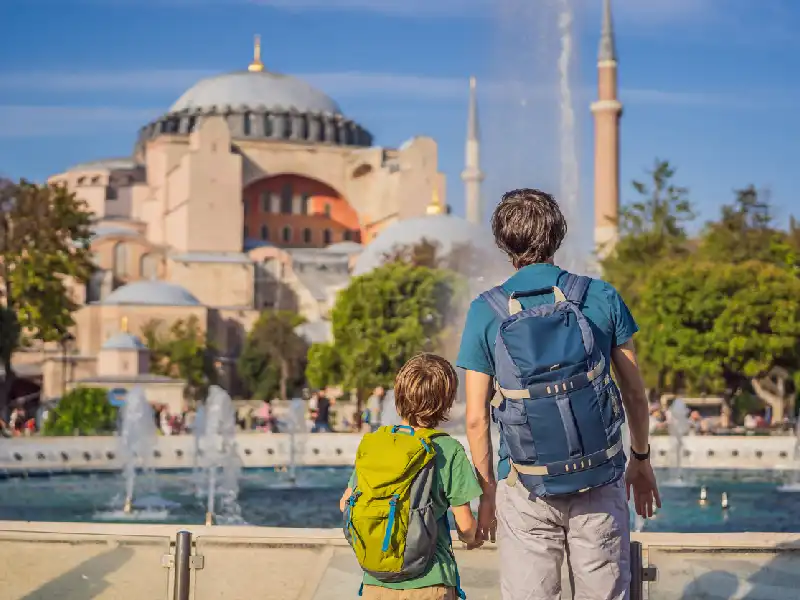
Museum Period
Kemal Atatürk's secular Turkish Republic converted Hagia Sophia into a museum in 1934. They wanted it to be "a repository of human history—all human history, not a single history confined to one religion or people". The Byzantine Institute of America worked from 1931 to 1949 to expose and preserve the building's mosaics.
Hagia Sophia gained worldwide recognition because of its cultural and architectural importance. UNESCO incorporated it into the Historic Areas of Istanbul World Heritage site in 1985. This iconic landmark became Turkey's most visited tourist site by 2019.
Reversion to Mosque
Turkey's Council of State cancelled the 1934 cabinet decision to convert Hagia Sophia into a museum on 10th July 2020. President Recep Tayyip Erdoğan then formally reopened the site as a mosque. The move sparked global controversy. UNESCO, the World Council of Churches, and other global leaders were worried, while numerous Muslim leaders welcomed the conversion.
Large curtains now cover the Christian mosaics, including Virgin Mary and Jesus Christ, at prayer times. These adjustments respect Islamic prayer while keeping the religious elements of the structure intact. Hagia Sophia remains a powerful symbol of Istanbul's rich and complex religious and cultural history.
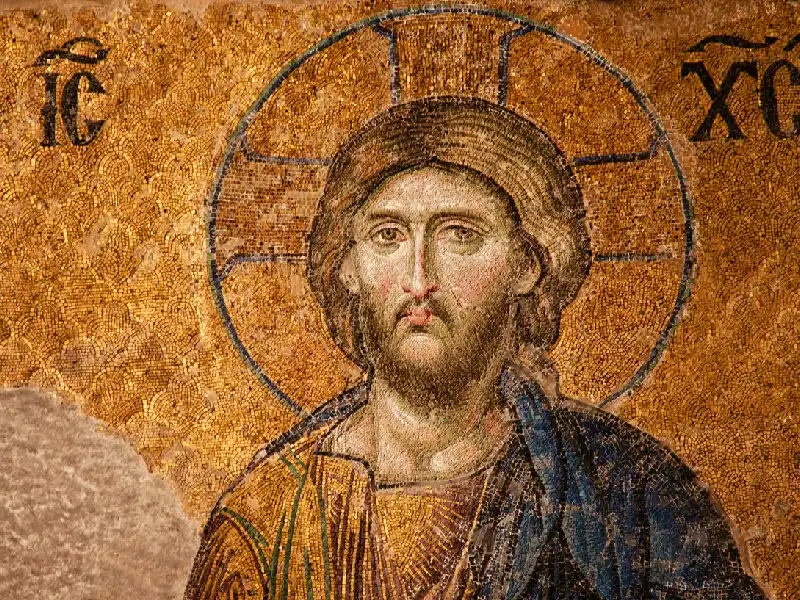
Architecture and Design
Hagia Sophia stands as an innovative sacred space, beautifully combining Eastern and Western architectural influences. Sacred buildings of different faiths have borrowed its architectural innovations for more than a thousand years.
Dome and Structural Innovations
Its crowning glory is the enormous central dome. It is about 31 meters wide and stands 55.6 meters high. Light filters through streams through forty arched windows on the lower part of the dome, creating the illusion that it floats in mid-air above the vast interior. Pendentives – triangular sections that transition the circular base to its square base – were used by the architects in the achievement of this engineering feat.
Traditional basilicas needed to be supported by thick walls. Isidore of Miletus and Anthemius of Tralles, builders of Hagia Sophia, came at the challenge with a different approach. They used a system of point support where 12 great piers inside the building bear the weight. By doing this, they used thin curtain walls between the supports, thereby creating amazing openness and lighting.
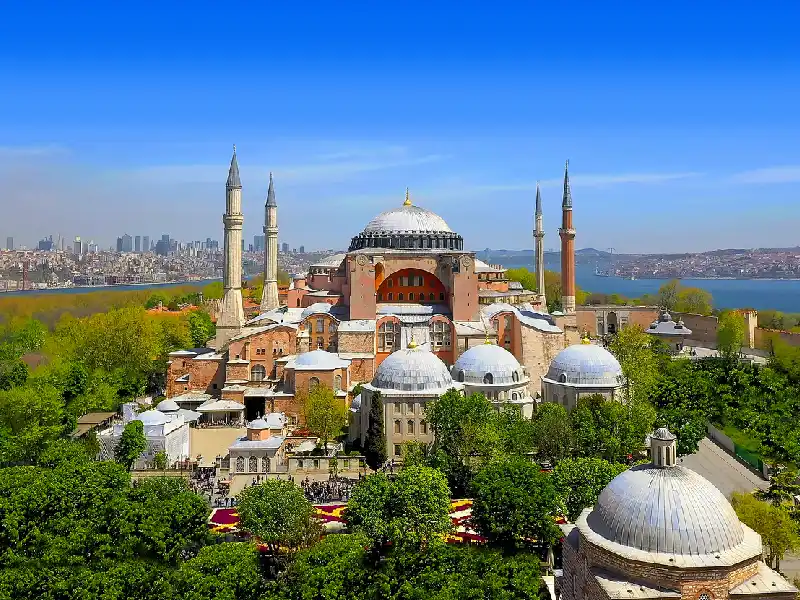
Interior Decorations and Mosaics
The interior welcomes guests with stunning artistic splendor. Precious marble panels in various colors adorn the lower walls – green Thessalian, purple Egyptian porphyry, and yellow Syrian. Gold mosaics above catch light and create an otherworldly atmosphere.
The mosaics' designs changed dramatically over time. Non-figurative designs emerged under Justinian's reign. The post-iconoclastic period (after 843 CE) saw the introduction of magnificent pieces that were figurative in nature. The apse showcases a breathtaking mosaic of the Virgin Mary with Christ Child. Everybody calls this the first significant post-iconoclastic image of the building.
Minarets and Islamic Additions
The Ottoman conquest in 1453 ushered in architectural change that honored the original design of Hagia Sophia but redesigned it for Islamic worship. Four graceful minarets were built incrementally. Bayezid II built the red brick minaret and the lean northeast column, located at the southeast corner. Two similar western minarets were built by Selim II afterwards.
The interior of the mosque blends harmoniously Islamic motifs with Byzantine features.
There were new additions in the form of a mihrab (prayer niche) showing the direction of Mecca, a minbar (pulpit), and distinctive Islamic calligraphy unlike any other mosque in the world. That architectural blend makes Hagia Sophia a singular monument where two significant religious traditions come together in material expression.
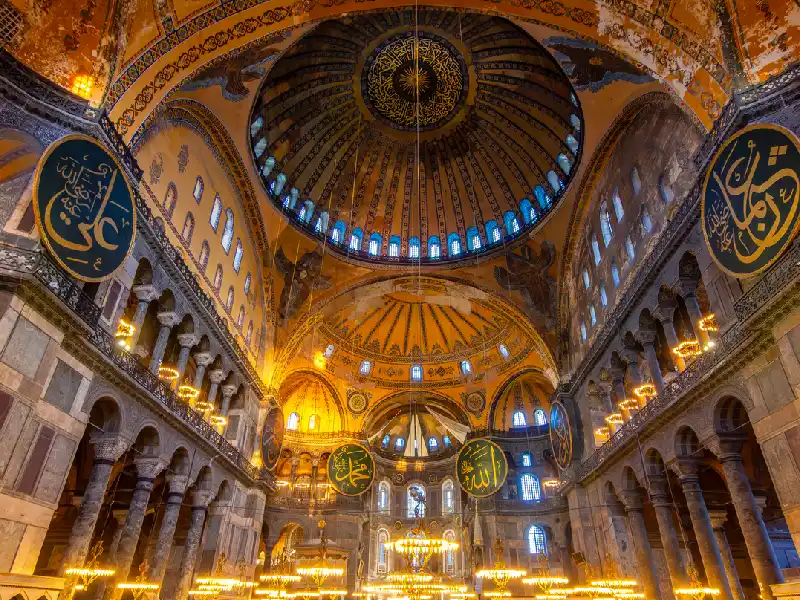
Religious and Cultural Significance of Hagia Sophia
Hagia Sophia has surpassed its physical structure to become a powerful symbol for multiple faiths and cultures. This extraordinary building shows evidence of Istanbul's religious development and connects different spiritual traditions.
Influence on Global Architecture
Architects worldwide draw inspiration from Hagia Sophia's innovations. Its unique dome and pendentive system became the standard model for Eastern Orthodox church architecture. Ottoman mosque designs borrowed heavily from Hagia Sophia's features. The central dome and supporting arches appear in buildings like the Blue Mosque.
Hagia Sophia's influence continues globally today—from Washington D.C.'s Basilica of the National Shrine to Serbia's Church of St. Sava. The building represents an architectural conversation between East and West. It embodies building techniques passed down from Graeco-Roman, Persian, and earlier civilizations.
Hagia Sophia Today
Planning a visit to Hagia Sophia? Here's what you need to know about this iconic Istanbul landmark that has witnessed centuries of history.
Location
Hagia Sophia sits at the heart of Istanbul's historic Sultanahmet district on the European side of the city. You'll find it at Sultan Ahmet, Ayasofya Meydanı. The mosque's location is perfect - just 260 meters from Topkapi Palace, so you can see both sites in one day. Staying in Sultanahmet? Most hotels are within walking distance. From Istanbul International Airport, you'll need to travel about 20km to reach this historic site.
Opening Hours
Hagia Sophia welcomes visitors from 9:00 am to 7:30 pm daily in 2025, with final entry at 6:30 pm. The building stays open 24 hours for worshippers since its 2020 conversion to a mosque. Non-worshippers should know that the mosque closes during daily prayer times.
Friday brings a longer closure from 12:30 pm to 2:30 pm for midday prayers. Check the current prayer schedule before your visit. Want the best experience? Come early on weekdays when crowds are smaller. Most first-time visitors spend about 30-45 minutes at the site.
Dress Code
Hagia Sophia's status as an active mosque means strict dress rules apply. Women must wear a headscarf inside and clothes that cover their shoulders and knees. Men need similar coverage - no shorts allowed.
Everyone must take off their shoes before stepping on the mosque's carpeted areas. Wear socks or get plastic foot coverings at the entrance. These rules show respect for this extraordinary monument that serves as both a sacred space and cultural treasure.
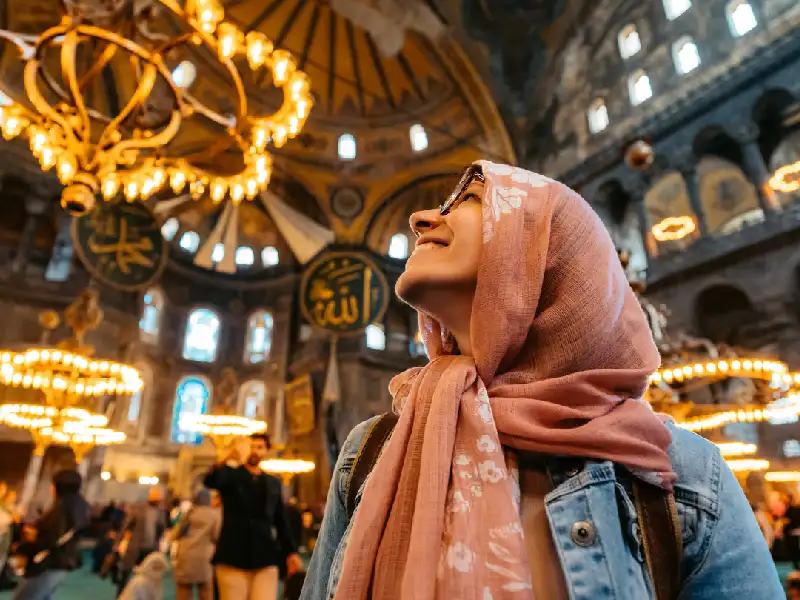
Frequently Asked Questions
Q1: What is Hagia Sophia and why is it so famous?
Hagia Sophia is a historic architectural masterpiece in Istanbul that has served as a cathedral, mosque, museum, and now a mosque again. It’s famous for its massive dome, rich religious history, and unique blend of Byzantine and Ottoman architecture.
Q2: Where is Hagia Sophia located today?
Hagia Sophia stands in the heart of Istanbul’s historic Sultanahmet district, just opposite the Blue Mosque and near Topkapi Palace, making it a central landmark in Turkey's cultural capital.
Q3: Is the Hagia Sophia a mosque or church?
Today, Hagia Sophia functions as a mosque. Originally built as a Byzantine cathedral in 537, it was later converted into a mosque, then a museum, and officially reconverted to a mosque in 2020.
Q4: Are non-Muslims allowed to visit Hagia Sophia?
Yes, non-Muslims are welcome to visit Hagia Sophia outside of prayer times. Visitors should dress modestly and respect the sacred atmosphere, as it is an active place of worship.
Q5: What time is best to visit Hagia Sophia?
Early morning or late afternoon on weekdays is ideal to avoid large crowds. Avoid visiting during Friday noon prayers, when access may be limited due to worship services.
Discover Hagia Sophia and the best of Turkey on our Turkey Tours and Middle East trips!










